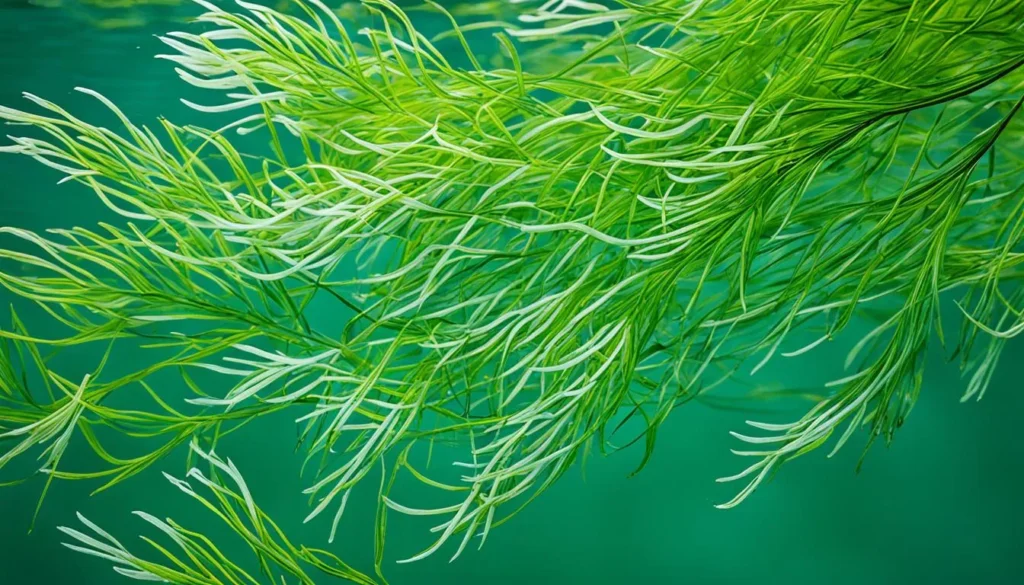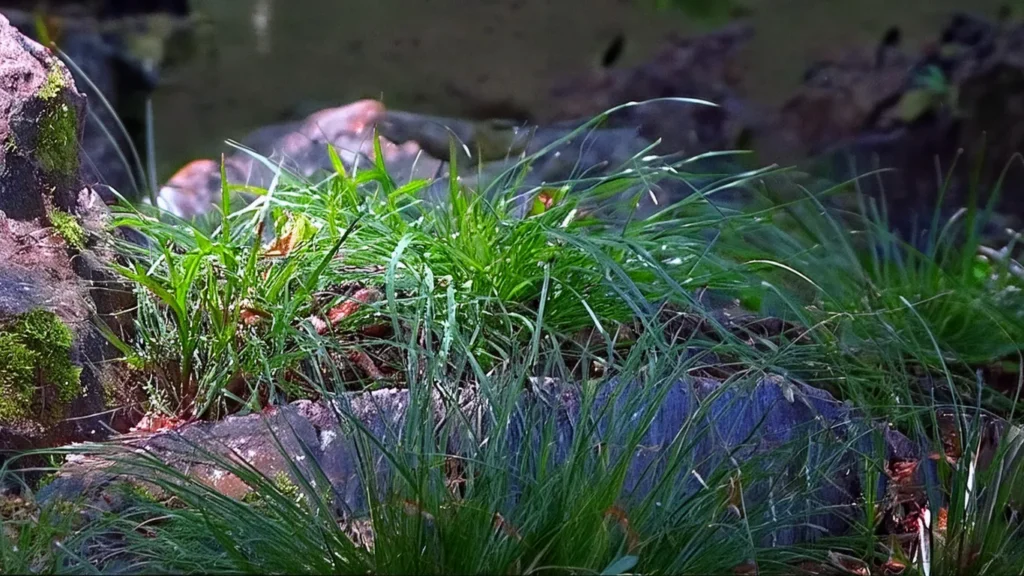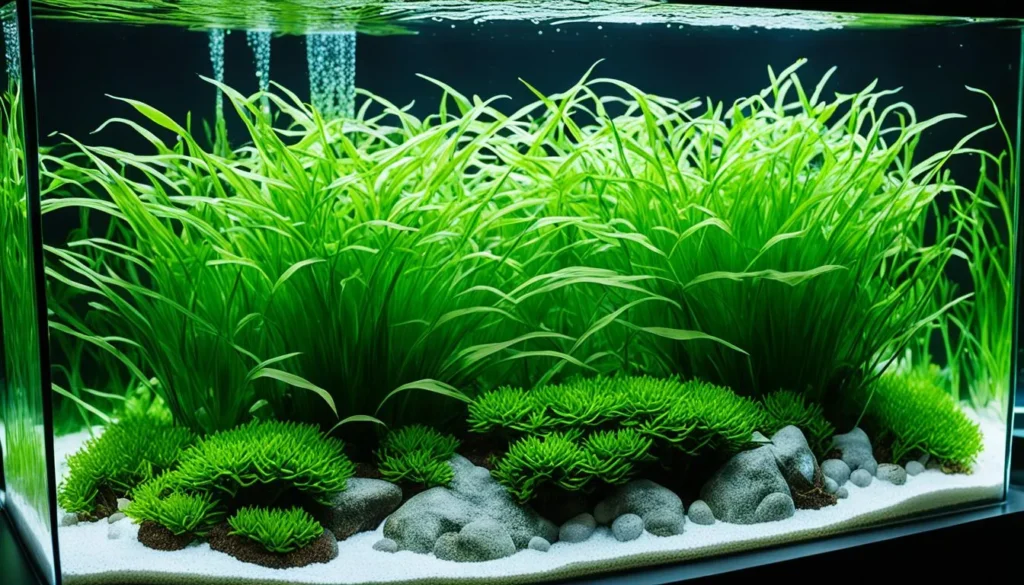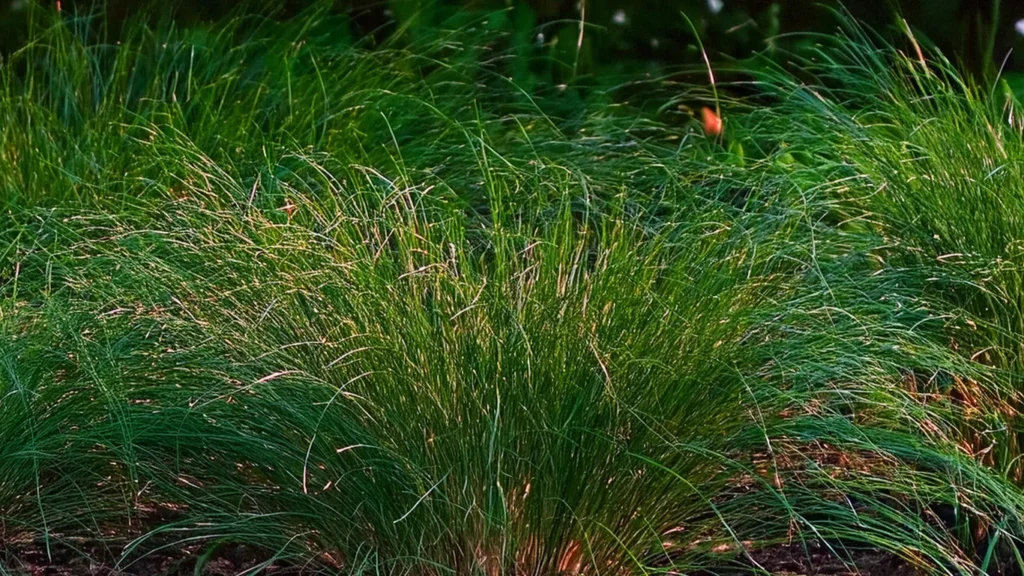Welcome to our comprehensive guide on Helanthium Tenellum, the versatile and beautiful carpeting plant that can transform your freshwater aquarium into a vibrant and captivating underwater landscape.
Helanthium Tenellum, also known as the chain sword or narrow leaf sword, is highly valued by aquarists for its ability to create dense and delicate aquatic lawns.
In this guide, we will cover everything you need to know about cultivating and maintaining Helanthium Tenellum in your own aquarium.

Key Takeaway
- Helanthium Tenellum is a popular freshwater plant that creates lush and vibrant aquatic aquarium lawns.
- It is a carpeting plant that can form dense carpets of foliage, adding a natural and aesthetic appeal to any aquascape.
- Proper aquarium conditions, including optimal water parameters, appropriate lighting, and nutrient-rich substrate, are crucial for the successful growth of Helanthium Tenellum.
- Regular care and maintenance, such as pruning, fertilization, and water changes, are important for the long-term health and vitality of the plant.
- Helanthium Tenellum can be propagated through division, offshoots, and tissue culture, allowing for the expansion and propagation of beautiful carpets in your aquarium.
Quick Stats
| Attribute | Details |
| Family Name | Alismataceae |
| Origin | North and South America |
| Height | 5-10 cm (2-4 inches), can reach taller heights in less intense light |
| pH Range | 6.0 – 7.5 |
| CO2 Requirement | Low to Moderate |
| Growth Rate | Moderate to Fast |
| Care Level | Easy to Moderate |
| Color Form | Green |
| Water Conditions | 22-28°C (72-82°F), adaptable to a wide range of hardness |
| Max Size | Leaves up to 10 cm (4 inches) long, with runners spreading wider |
| Lighting | Moderate to High |
| Supplements | CO2 beneficial for dense carpets; root tabs and liquid fertilizers support growth |
| Placement | Foreground |
| Propagation | By runners |
What Is Helanthium Tenellum?
Helanthium Tenellum, also known as the chain sword or narrow-leaf sword, is a fascinating aquatic plant that has gained popularity in the world of aquascaping.
Native to South America, this plant is highly valued for its ability to create lush and dense carpets in freshwater aquariums.
Its delicate and vibrant foliage adds a touch of natural beauty to any aquascape, making it a favorite choice among aquarists.
RELATED: Cultivating Alternanthera Lilacina At Home
Natural Habitat And Origin
Helanthium tenellum, formerly known as Echinodorus tenellus, is native to North and Central America.
It is commonly found in the United States, Mexico, and parts of Central America, where it inhabits marshes, wetlands, and shallow waters with sandy or muddy substrates.
This aquatic plant often grows emersed or partially submersed along the edges of ponds, streams, and marshy areas.
Helanthium tenellum is also cultivated as a popular aquarium plant, valued for its attractive appearance and ease of care.

Physical Characteristics
- Size: Helanthium tenellum typically grows to a height of 5-10 centimeters (2-4 inches), making it suitable for both foreground and midground planting in aquariums.
- Leaves: The leaves of Helanthium tenellum are narrow and ribbon-like, with a vibrant green coloration. They are arranged in a dense rosette pattern, forming a carpet-like appearance when planted densely.
- Growth Form: This plant spreads horizontally by sending out runners, which develop into new plantlets at nodes along their length. As a result, it can quickly form a lush carpet across the substrate in aquariums.
- Root System: Helanthium tenellum has a fibrous root system that anchors the plant to the substrate. The roots are relatively short and delicate, allowing the plant to take up nutrients efficiently from the substrate.
Lighting Requirements To Enhance Plant Vitality
- Proper lighting is essential for the photosynthesis process in Helanthium Tenellum. Moderate to high lighting levels are recommended to promote healthy growth and vibrant foliage. This can be achieved through the use of high-quality LED aquarium lights or fluorescent tubes with a color temperature of around 6500K.
- It is important to provide a lighting duration of 10-12 hours per day, replicating a natural day-night cycle for the plants. Using a timer for consistent lighting schedules will ensure that your Helanthium Tenellum receives the appropriate amount of light for optimal growth.
Temperature Parameters
Helanthium tenellum, commonly known as pygmy chain sword, thrives in aquariums with tropical water temperatures.
Here are the recommended temperature parameters for optimal growth:
- Temperature: Maintain the water temperature between 22°C to 28°C (72°F to 82°F) for healthy growth of Helanthium tenellum. This range mimics the plant’s natural habitat conditions and supports vigorous growth and propagation.
- Consistency in temperature is crucial to prevent stress and ensure the plant’s well-being. Use a reliable aquarium heater and monitor water temperature regularly to maintain stability. Additionally, ensure that temperature fluctuations are minimal to avoid any adverse effects on the plant’s growth and overall health.
Optimal Water Parameters For Helanthium Tenellum Growth
Helanthium Tenellum thrives in freshwater aquariums with stable and suitable water parameters.
The following are the ideal conditions for its growth:
- Temperature: 75-82°F (24-28°C)
- pH: 6.5-7.5
- Hardness: Soft to moderately hard
- Ammonia, Nitrite, and Nitrate levels: Low to zero
- Carbon Dioxide (CO2) levels: 20-30 ppm

Substrate Choices For Root Nourishment
The choice of substrate plays a crucial role in providing the necessary nutrients for the root development of Helanthium Tenellum.
A nutrient-rich substrate will support the growth and anchorage of the plant. Here are some preferred substrate choices:
| Substrate Types | Features |
| Aquasoil | Rich in nutrients, stimulates plant growth |
| Sand | Provides stability and allows for nutrient absorption |
| Gravel | Allows for water circulation and root penetration |
The choice of substrate ultimately depends on personal preference, tank setup, and the overall desired aesthetics of your aquarium.
It is generally recommended to use a combination of substrates or layering techniques to create a more diverse and nutrient-rich environment for Helanthium Tenellum.
Placement Option
- Foreground: Helanthium tenellum is often used as a foreground plant due to its relatively short stature and carpeting growth habit. Planting it in the foreground creates a lush green carpet effect that adds depth and visual interest to the aquarium.
- Midground: While Helanthium tenellum is primarily a foreground plant, it can also be placed in the midground area of the aquarium. Use it to transition between foreground and background plants or to fill in gaps between larger plants or hardscape features.
- Accent Plant: Plant individual specimens or small clusters of Helanthium tenellum as accent plants in various areas of the aquarium. This can help break up open spaces, add texture, and create focal points within the aquascape.
- Along Hardscape: Helanthium tenellum can be planted around hardscape features such as rocks, driftwood, or aquarium decorations. This helps soften the edges of the hardscape and creates a natural transition between the hardscape and the substrate.
- Borders and Edges: Plant Helanthium tenellum along the borders or edges of the aquarium to frame the tank and create a cohesive look. This helps define the boundaries of the aquascape and adds a finishing touch to the overall design.

Recommended Tank Size
- For a small carpet or accent planting: A tank size of 10 gallons (38 liters) or larger would be suitable for a small carpet or accent planting of Helanthium tenellum.
- For a larger carpet or extensive planting: A tank size of 20 gallons (75 liters) or larger would be more appropriate for creating a larger carpet or extensive planting of Helanthium tenellum.
Companion Plants And Fish Or Helanthium Tenellum Aquariums
In addition to Helanthium Tenellum, incorporating suitable companion plants and fish can enhance your aquarium’s overall beauty and ecological balance.
When selecting companion plants, it’s important to consider their compatibility with Helanthium Tenellum’s growth requirements and aesthetic appeal.
When choosing companion plants for your Helanthium Tenellum aquarium, consider species with similar environmental preferences regarding lighting, water temperature, and water chemistry.
Some compatible aquatic flora options include:
- Anubias barteri
- Cryptocoryne species
- Java fern (Microsorum pteropus)
- Bacopa Carolinians
When selecting fish for your Helanthium Tenellum aquarium, opt for peaceful species compatible with the water parameters required by the plants and other fish and are not prone to uprooting or eating the delicate plant’s foliage.
Some suitable companion fish include:
- Neon tetras (Paracheirodon innesi)
- Honey gouramis (Trichogaster chuna)
- Otocinclus catfish
- Kuhli loaches
Nutritional Needs Of Helanthium Tenellum
- Macronutrients: Helanthium tenellum requires essential macronutrients such as nitrogen (N), phosphorus (P), and potassium (K) for healthy growth. These nutrients are often available in the aquarium water from fish waste, decaying organic matter, and regular water changes. However, if deficiencies are observed, you can supplement with aquarium fertilizers containing these macronutrients.
- Micronutrients: Helanthium tenellum also benefits from micronutrients such as iron (Fe), manganese (Mn), and other trace elements. These micronutrients are essential for various metabolic processes and enzyme functions within the plant. Micronutrient deficiencies can be addressed by supplementing with liquid fertilizers or root tabs containing trace elements.
- Carbon (CO2): While Helanthium tenellum can grow without supplemental CO2, providing a source of carbon dioxide can enhance growth and promote vibrant coloration. CO2 injection systems or liquid carbon supplements can be used to supplement carbon in planted aquariums.

Helanthium Tenellum Cultivation Tips
- Lighting: Provide moderate to high-intensity lighting to mimic the plant’s natural habitat conditions. Aim for a lighting duration of 8 to 10 hours per day to support photosynthesis and healthy growth. LED or fluorescent lighting fixtures designed for planted aquariums are suitable options.
- CO2 Injection: While Helanthium tenellum can grow without supplemental CO2, providing a source of carbon dioxide can enhance growth and promote vibrant coloration. Consider using a CO2 injection system to provide adequate carbon dioxide levels for optimal photosynthesis. Alternatively, liquid carbon supplements can be used as an alternative.
- Nutrient Supplementation: Ensure that the aquarium water is rich in essential nutrients, including nitrogen, phosphorus, potassium, and micronutrients. Regularly dose liquid fertilizers or use root tabs to provide nutrients to the substrate. Monitor nutrient levels and adjust fertilization as needed based on plant growth and water parameters.
- Substrate: It benefits from a nutrient-rich substrate with fine grains to anchor its delicate roots. Choose substrates specifically designed for planted aquariums, such as nutrient-rich aquasoils or fine gravel mixed with laterite. A depth of at least 2-3 inches (5-8 cm) is recommended to allow for proper root penetration and stability.
Plant Propagation Tips
- Runners: Helanthium tenellum naturally produces runners, which are horizontal stems that grow along the substrate. These runners develop new plantlets at nodes along their length. Allow the runners to grow and develop plantlets until they have formed roots of their own. Once the plantlets have established roots, they can be carefully separated from the parent plant and replanted elsewhere in the aquarium.
- Division: If the Helanthium tenellum has formed dense clumps, you can divide it into smaller portions. Carefully separate the clumps into individual sections, ensuring that each section has both roots and leaves. Replant these sections in the substrate, spacing them appropriately to allow for growth.
- Trimming and Planting Clippings: Use sharp scissors or aquascaping tools to trim the tops of the Helanthium tenellum. These clippings can be replanted directly into the substrate, where they will take root and grow into new plants. Ensure that each clipping has some roots attached for successful propagation.
- Encouraging Growth: To encourage propagation, provide optimal growing conditions, including adequate lighting, nutrient supplementation, and CO2 (if applicable). Regularly monitor the plant for new growth and adjust care as needed to promote healthy propagation.
RELATED: The Elegant Aquatic Design With Anubias Hastifolia
The Role Of Helanthium Tenellum In Eco-Balanced Aquatic Environments
- This plant plays a significant role in establishing and maintaining eco-balanced aquatic environments. As a carpeting plant, it forms a dense and intricate network of roots that helps prevent soil erosion and provides a habitat for beneficial bacteria and microorganisms.
- These organisms aid in the breakdown of organic waste and the conversion of harmful substances, contributing to a healthier and more stable aquarium ecosystem. Additionally, the bright green foliage of Helanthium Tenellum enhances the overall aesthetic appeal of the aquascape, creating a visually pleasing and harmonious underwater landscape.
| Key Attributes of Helanthium Tenellum | Benefits in Aquascaping |
| Slow growth and compact size | Allows for precise and controlled placement |
| Narrow leaves | Adds a sense of height and elegance to the aquascape |
| Creates dense carpets of foliage | Enhances the visual appeal of the aquarium |
| Establishes eco-balanced environments | Contributes to water quality and stability |
Managing Plant Diseases And Pests
- Helanthium Tenellum is susceptible to plant diseases and pests like any other plant. Common issues include fungal infections, root rot, and pest infestations, such as snails or aquatic insects.
- To manage plant diseases, it is crucial to maintain good water quality, remove any decaying plant matter promptly, and ensure proper aquarium hygiene. For pest control, manual removal, introducing natural predators, or using targeted treatments can be effective strategies to maintain a healthy ecosystem.

Conclusion
This plant is a highly versatile and popular aquatic plant that allows aquarists to create stunning and vibrant aquascapes in their home aquariums.
By understanding the unique characteristics of Helanthium Tenellum and providing optimal conditions, aquarists can cultivate and enjoy the beauty of this delicate aquatic lawn plant.
Through this comprehensive guide, we have explored the various aspects of cultivating and maintaining Helanthium Tenellum, including its role in eco-balanced aquatic environments, optimal aquarium conditions for growth, propagation methods, common challenges, and design techniques.
With this knowledge, aquarists can confidently master the art of creating captivating aquascapes.
By implementing effective care and maintenance routines, such as regular pruning, fertilization, and water changes, aquarists can ensure the long-term health and vitality of this plant.
Additionally, considering companion plants and fish that enhance the aquascape can add further visual interest and create a harmonious ecosystem within the aquarium.
Frequently Asked Questions
What Are Some Common Challenges In Keeping Helanthium Tenellum?
Algae issues, nutrient imbalances, plant diseases, and pests are common challenges in maintaining Helanthium Tenellum.
These challenges can be addressed through proper nutrient supplementation, effective filtration, and maintaining a healthy aquatic ecosystem.
How Can I Design An Appealing Aquascape With Helanthium Tenellum?
Designing an appealing aquascape involves careful composition and plant placement. Depending on the desired effect, Helanthium Tenellum can be used as a foreground or midground plant.
Creating focal points, utilizing the rule of thirds, and incorporating different textures, colors, and heights of plants can add depth and visual interest to the aquascape.
What Are Some Companion Plants And Fish That Go Well With Helanthium Tenellum?
When selecting companion plants, consider their compatibility with Helanthium Tenellum’s growth requirements.
Adding fish that enhance the aquascape and invertebrates that act as cleaners can further enhance the ecosystem.
Researching and matching compatible plant species and fish is crucial for maintaining a harmonious aquatic environment.
How Do I Aesthetically Prune Helanthium Tenellum?
Aesthetic pruning is necessary to maintain the desired shape and appearance of this plant.
This involves trimming excessive growth, removing dead or yellowing leaves, and maintaining the desired height and density.
Clean and sharp tools should be used to prevent damage and the introduction of potential diseases.
What Insights Can Expert Aquascapers Offer On Using Helanthium Tenellum?
Expert aquascapers provide valuable insights on leveraging design principles, showcasing award-winning layouts with Helanthium Tenellum, and sharing their unique aquascaping philosophies.
Learning from their expertise can inspire and guide aquarists in creating captivating and visually stunning aquascapes.
- Unveiling The Wonders Of Riccia Fluitans In Aquascapes - August 7, 2024
- Vallisneria Gigantea Var. Guide To Care And Cultivation At Home - July 31, 2024
- Vesicularia Dubyana Care & Growth Guide Tips For Beginner Gardeners - July 30, 2024
